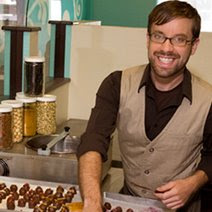Macadamia Orange Peel
Up and running in the truffle case (as of today!) is an old favorite of mine that hasn't made an appearance since the cafe opened last October. Macadamia Orange Peel is one my two original white chocolate truffles and arguably among my most popular.
"Blah! White chocolate! That's not even real chocolate", I hear some of you boo and hiss. Oh contraire, my couveture-coated friends, white chocolate is among the creamiest and smoothest chocolates around. In fact, properly made, by definition it IS the creamiest chocolate... or at least should be. Allow me to explain:
The chocolate pod, or Theobroma Cacao, is split open in the fields and allowed to ferment and dry on the spot. It is then shipped to chocolate manufacturers who process it to yield batches of finished chocolate hundreds of pounds at a time. Our manufacturer, Guittard in San Francisico, refines the cacao upwards of two weeks (!) before yielding very fine couverture chocolate which we purchase in large quantities to create our signature truffles and exotic chocolate bars. But I digress...
When a manufacture receives the cacao beans, among the first steps towards chocolate bliss is to press the cacao to divide it into its two primary parts: Cocoa Liquer and Cocoa Butter. While these components are later recombined to create the finished chocolate, this is done first so that the portions of each can be manipulated to yield chocolates with specific properties. Under great pressure the beans are squeezed until they literally bleed the preciously unctuous Cocoa Butter.
It is at this point where the value of chocolate is determined. Cocoa Butter, because it is all-natural and melts at body temperature, is not only coveted by chocolatiers, but also by those titans of the skin care industry. It is this supply-and-demand factor that separates the good chocolates from the bad. Premium chocolate, or couveture chocolate (meaning coating in French), contains very high percentages of Cocoa Butter, while low-end chocolate-makers frankly can't afford the costs. Very low-end chocolates sometimes even replace the Cocoa Butter with vegetable oils. Yuck! This is how bad chocolate is often described as hard and waxy.
"What does this have to do with white chocolate, already? (grumble grumble)"... I'm getting to it!
Dark chocolate contains Cocoa Liquer (the darkness from the bean) and Cocoa Butter (the fat), and the combined weight of these components is referred to as Cocoa Mass. When you see a chocolate bar with a listed percentage, such as my 60% Blackberry Sage bar, you are, in short, eating a chocolate that is 60% derived from the cacao pod and 40% sugar. In comparison, baking chocolate (or unsweetened chocolate) is literally 99% Cocoa Mass.
Milk chocolate contains these two components, but also relies on milk powder for creaminess. Therefore my 36% Mango Masala bar is roughly 36% from the pod and 64% sugar and milk powder.
White chocolate is the exception. It contains no Cocoa Liquer, but instead contains very high proportions of Cocoa Butter... at least it should! My Macadamia Ginger bar is listed as 31% cacao content, which makes it nearly one-third Cocoa Butter, and thus VERY creamy. In comparison "bad" white chocolates can contain cacao contents as low as single-digits, or none at all (think veggie oils). Yuck!
So what makes my Macadamia Orange Peel truffle so popular? The fact that it begins to melt the moment it hits your tongue. I promise with the high percentages of Cocoa Butter and heavy cream packed into these little babies, you will love them, too.
Oh, and they are infused with orange peel and topped with toasted macadamia nuts. Yum:
-









1 comment:
yum!
Post a Comment